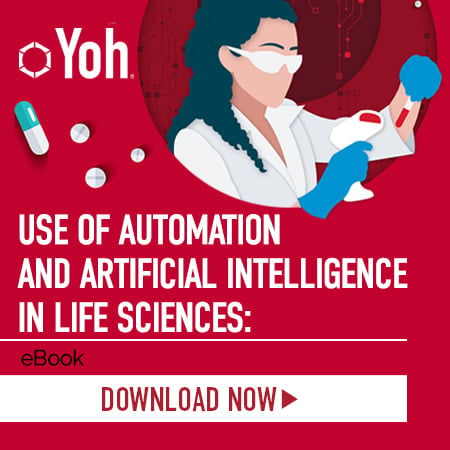Life Sciences
Better living through better science provided by better talent. Yoh knows life sciences.
Laboratory Sciences
The right professionals for your lab.
Learn More
Clinical Research
Innovative clinical talent for every phase.
Learn More
Validation, Quality & Compliance
Top VQC talent at the right time.
Learn More
Medical Writing
Skilled medical writing talent on time, every time.
Learn More
Medical Affairs
Ensuring your products are market-ready with the help of great talent.
Learn More
Clinical Trial Disclosure
The right experts for every stage of trial disclosure
Learn More
THE SCIENCE OF GREAT TALENT
Unique Solutions to Common Resourcing Challenges
A customized talent solutions approach within the Pharmaceutical, Biotech, and Device industries.
Yoh Life Sciences provides strategic resourcing and staffing solutions to the Life Sciences industry. As an extension of your organization, we bring an expert suite of services that are both flexible and scalable. Yoh offers a customized approach within the Pharmaceutical, Biotech, and Device industries, providing a range of talent solutions. Whether you require individual consultant-contractors who are subject-matter experts (SMEs) or complete functional teams, we deliver the talent you need, when you need it.
Leveraging 30+ years of industry expertise, Yoh provides a wide range of services and follows best practices designed to deliver high-quality talent on time, every time. Through a singular Life Sciences focus, our dedicated SMEs provide consultative guidance ensuring delivery timelines and milestones are met.
TRUSTED SUPPORT
Yoh is a proven partner across the Pharmaceutical, Biotech, and Device industries. Our in-depth understanding of Life Sciences allows us to deliver tailored solutions that cater to your demands. With our industry focus and network of skilled professionals, Yoh has the knowledge and resources to support your growth and success. Our suite of services extends from early research and development to post approval and marketing within the following areas.
CLINICAL RESEARCH
- Data Management, SAS, STAT
- Trial Administration, Monitoring & Management
-
Medical Communications & Marketing
MEDICAL AFFAIRS
- KOL Engagement & Medical Education
- Clinical Development & Lifecycle Management
- Health Economics & Outcomes Research
MEDICAL WRITING
- Regulatory Submissions & Safety Reports
- Clinical Protocols & Reports
- Manuscripts, Grants & Medical
CLINICAL TRIAL DISCLOSURE
- Clinical Trial Registration & Results
- Plain Language Summaries
- Medical Writing
LABORATORY SCIENCES
- Study Associates
- Research Scientists
- Laboratory Management
VALIDATION, QUALITY & COMPLIANCE
- Full Suite IQ, OQ, PQ
- Process Validation
- Regulatory Compliance – Auditing
WHY YOH LIFE SCIENCES?
A TAILORED APPROACH
Yoh invests the time to understand your individual and corporate objectives, technical requirements, and culture environment to ensure greatest resource fit and maximize retention. We pride ourselves in a balanced approach of meeting immediate resourcing needs while understanding your future capacity planning and demand management.
SUBJECT-MATTER EXPERTISE
Yoh’s teams of industry veterans are rooted in Life Sciences and known for both their market knowledge and the caliber of their networks. Our recognized SMEs will effectively shape your talent strategies and delivery within the highly regulated and competitive Life Sciences sector.
Workforce solutions that flex with your business.
Recruiting Services
Need to scale fast with the right talent? Yoh connects you to specialized professionals who hit the ground running, whether you need short-term support, permanent hires, or full project teams.
Explore Recruiting Services >
Functional Service Provision
From clinical trial operations to lab management and regulatory compliance, Yoh’s FSP model gives you dedicated, embedded teams tailored to your systems, processes, and goals.
Explore Functional Service Provision >






